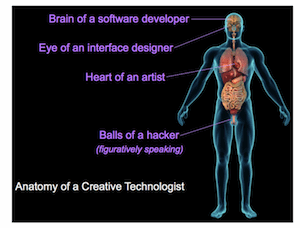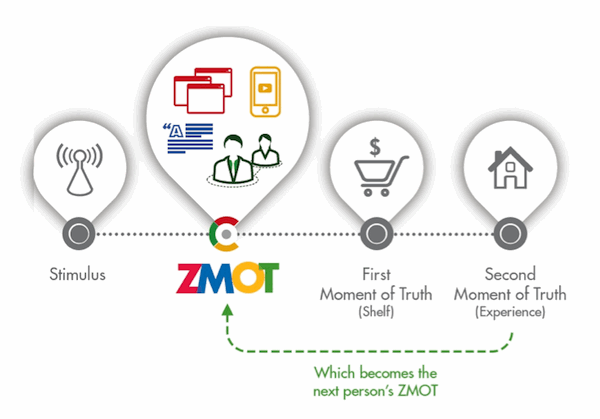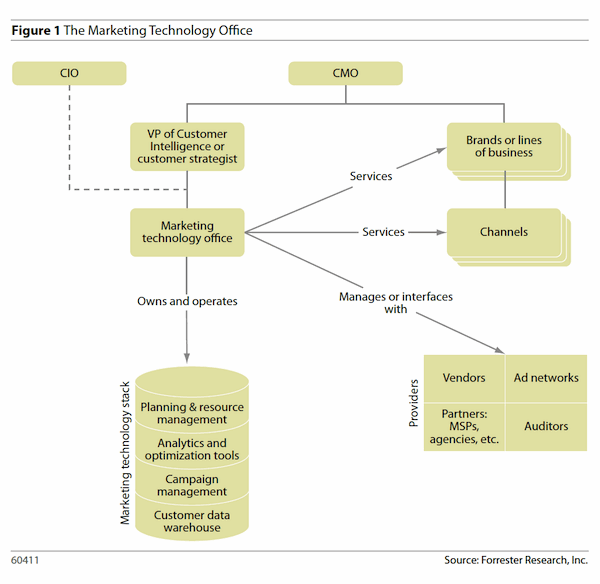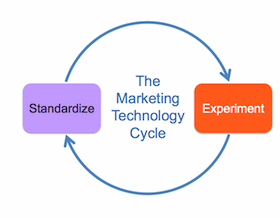Today I’m presenting at Adobe’s Partner Community Day in New York City on the topic of the rise of marketing technologist.
This is an updated and extended version of talks I gave last year at Search Insider Summit and Pivot. Since a large number of agencies will be in the audience, I’ll also discuss what this marketing technologist revolution means for them.
Here are the slides:
And here’s an essay version of my talk:
Rise of the Marketing Technologist (and What It Means for Agencies)
Greetings! It helps to know a little about who’s making proclamations. As a brief introduction, I’ve been a hybrid software developer and marketer since the early days of the Web. For the past four years, I’ve been blogging about the intersection of these two disciplines and how technology is changing the practice and management of marketing. In 1998, I co-founded an interactive agency that survived and thrived through the first dot-com bubble. About 5 years ago, we transformed that agency into a specialized marketing technology vendor, ion interactive, with customers such as Dell, DHL, General Mills, Intuit. I’ve had the privilege of seeing the evolution of marketing technology from several perspectives.
So what’s a marketing technologist, anyway? Is it just another label for a digital strategist? A creative technologist? Something else?
First, a word on digital. Using highly advanced predictive analytics, I think we can call this fight: digital has won. Sure, there might be a few skirmishes out there, but the writing is on the Facebook wall. For a few points on the curve, consider the stats published by AdAge in July showing how jobs growth is skyrocketing in Internet media — even through our pseudo-recession — while jobs have been stagnating or shrinking in traditional media. Or the latest STRATA survey of agency executives showing digital now on par with TV as the medium of choice.
But probably the best evidence of digital’s supremacy is the Apple Store. Laptops, smartphones, tablets — these are the devices that now serve as the interface between customers and companies, especially in the crucial “getting to know you” stage.
All this is to say that digital strategy and marketing strategy must be one and the same.
Given that, it’s no surprise that digital strategists have been fruitful and multiplied in agencies. In fact, most agencies are now on the second generation of digital strategists, where the role has forked to encompass digitally-savvy account planners and a bevy of digital marketing specialists for search engine optimization, paid search marketing, social media, display advertising, content marketing, mobile, and more.
It almost goes without saying: a digital strategist must be fluent in using technology. Actually, we can revise that more broadly: pretty much every modern marketer needs to be fluent in using technology.
But not necessarily building it.
Enter the creative technologist…
In agencies, this is where the creative technologist has emerged. What’s a creative technologist? Well, consider their anatomy: a great creative technologist has the brain of a software developer and the heart of an artist. Ideally, the eye of an interface designer. And often the balls of a hacker (figuratively speaking). The best creative technologists are fearless about tinkering, experimenting, pushing the envelope.
More formally, a creative technologist builds the technology for creative digital campaigns. (Obviously, right?) They’re the ones who work with HTML, CSS, Javascript, Flash, APIs, MVC frameworks, Facebook apps, iOS, Android, games, dynamic ads, and more. If you work in an agency and spend a lot of time on Facebook’s developers site, you’re probably a creative technologist.
This has led to the modern creative triumvirate: an art director, a copywriter, and a creative technologist — images, words, and code. And not just in some disconnected pipeline. This is a collaborative unit, with the technologists at the table from the beginning, brainstorming original creative concepts.
Skittles’ Experience The Rainbow. Nissan’s My Versa Road Trip. Even Adobe’s The Expressive Web, serving more of a B2P market. These are all terrific examples of the work produced with creative technologists. Really awesome stuff. And under the hood, pretty technically advanced.
Agencies are becoming more and more technically sophisticated — granted, some still faster than others. The digital strategist, in all its different incarnations, and the creative technologist are key roles. But they are primarily agency roles.
Something else is happening, across the agency-client client divide… a fundamental shift is underway in most marketing departments, from being technology adverse — to technology savvy.
The ZMOT changes everything
“I feel more like a CIO than a CMO! I have marketing automation, CRM, listening platforms — I’m up to my eyeballs in technology.” This is a quote from an exasperated CMO at the Forrester CIO-CMO Forum last month, and I think it perfectly sums up the magnitude of the transformation underway in marketing.
But let’s start with the root cause.
Not too long ago, marketing flowed like this:
- Consumers were exposed to a stimulus, such as advertising.
- Later, at the store, they would choose which product to buy — the “first moment of truth.”
- When they actually used the product at home, they would decide if they liked it — the second moment of truth.
This model is for consumer packaged goods, but there are analogies for more considered purchases and B2B. It enabled a nice division of labor. In this model, the stimulus was the agency’s responsibility. The product, the second moment of truth, was the marketer’s responsibility. And depending on the product and its distribution channels, they met somewhere in the middle at the first moment of truth.
But over recent years, that nice, simple model has been thoroughly disrupted by what Google calls the zero moment of truth, the ZMOT. After being exposed to a stimulus, prospects go online to learn about the product, the company, the category. Most importantly they go to get a sense of what real customers — people who have experienced that second moment of truth — have to say.
The ZMOT is a flurry of activity. Prospects query search engines, visit your web site, read educational content, follow related accounts on Twitter, visitor competitors’ sites, read reviews, discuss with friends, check online communities, comparison shop, etc. And it’s in this expansive and frenetic zero moment of truth that customers are now frequently won or lost.
This is the root cause of marketing’s disruption. And it’s worth digging deeper into what I see as the 5 killer properties of the ZMOT. They’re “killer” in the 80’s hyperbolic sense that they’re amazing — but also because, well, they can kill you (professionally speaking).
First, the ZMOT is almost entirely digital or digital-ish — even real world events, calls to call centers, visits with a sales rep, coupons from the store, discussions with friends sent via email or remarked on Facebook, etc., have a tendency to end up echoing somewhere in the digital domain.
Second, the ZMOT is not a single instant — it’s a whole stream of touchpoints. Google researched ZMOT activity for consumers in different categories and showed that, for instance, the typical automobile shopper acquires input from 18.2 different sources in considering a purchase — and over 97% of those shoppers are influenced at the ZMOT.
Third, the ZMOT is shaped by real-time dynamics. The FMOT lasts 7 seconds. But prospects live in the ZMOT for anywhere from a few hours to weeks or months, depending on the product category. A prospect’s perspective and interest evolves over this time period, and there’s a tremendous opportunity for marketing to adapt with them — and with respect to their digital vapor trail and external events. This includes personalization and retargeting, but it’s more than that.
Fourth, the ZMOT shatters boundaries between prospects, marketers, customers, competitors. Prospects don’t proceed neatly, lockstep through a funnel — they zoom in and out, up and down. Forrester published a terrific diagram of these cross-touchpoint customer experiences that reveal the cycles prospects go through — discover, search, research, compare, decide — leveraging the web, mobile, physical stores, call centers, and social media.
Which leads to the fifth, the ZMOT experience now defines brands. What used to be separate — your marketing/advertising, your product/service, your new prospects, your existing customers — is now being mashed together in the ZMOT. Everything intermingles, and from the first touchpoint onward, this whole enchilada is the new customer experience. And its feedback loop, like it or not, defines your brand.
Software to the rescue!
To sum up the impact of the ZMOT on marketing: it’s #$@%* complex!
In a recent study IBM did with hundreds of CMOs, 79% of them expect a high or very high level of complexity over the next five years. But only 48% of them feel prepared for that complexity. And I’d bet that at least half of those who think they are prepared are blissfully delusional. Because this world of the ZMOT customer experience is ridiculously complex.
Oh, and it’s hard to outsource. At least it’s hard to outsource wholesale. Because ultimately, the brand must own the customer experience. (“CX” for those in the know.)
So what do we do? How do we get control of this complexity?
The answer is contained in the problem: digital. Digital has some really wonderful properties. It’s measurable. It’s scalable. It’s malleable, much easier to alter bits than atoms. It’s frictionless. It’s fast. But most importantly…
It’s programmable by software.
And thanks to Moore’s Law, cloud computing and SaaS models, open source and expert communities, and a wealth of new languages and frameworks, it’s never been easier or faster to build great software. This huge opportunity for disruptive innovation in marketing combined with the fluidity of creating new software has triggered one of the greatest explosions in the history of commercial software: the expansive new field of marketing technology.
A couple of months ago, I took at pass at sketching this marketing technology landscape in an infographic. It’s terribly incomplete, with only a representative sample of 250 companies out of the thousands of specialized marketing technology vendors out there. But it gives you a flavor of the incredible scale and scope of marketing software.
Technology for promotion: the whole display advertising ecosystem, search ad management, social media marketing management, mobile marketing, SEO tools. Technology for the customer experience: core website platforms, e-commerce, landing pages and microsites, testing and optimization, video content, email marketing. Technology for the new marketing management: marketing resource management, web analytics, customer analytics, CRM, business intelligence, marketing automation, digital asset management.
My friends, we are in The Golden Age of Marketing Software.
This fountain of innovation is what gives us hope that the complexity of the ZMOT will be conquered. But in harnessing such technology, the nature of marketing shifts. I’ve written before that you are the software you use. Software is now the interface by which marketing sees and touches the world:
- Analytics shapes our perceptions of our audience
- Automation guides the processes we put in place
- Optimization encourages us to hone tactics in particular ways
- Listening platforms lead us to our choices of social engagements
- Targeting software defines our audience segments
- CRM platforms structure our relationships with customers
Software doesn’t just help marketers manage the new customer experience. It increasingly defines the customer experience. If you’ve ever spent time in a marketing automation platform such as Eloqua, you know what I mean — those flows and rules being arranged are mapping out touchpoints and experiences. It’s kind of surreal.
But all this potential wizardry raises a question… who’s choreographing this marketing technology ballet in your organization? Or is it more of a mosh pit?
IT vs. Marketing
In the “old days” — you know, a couple of years ago — marketing would simply hand off tech requests to the IT department. It wasn’t particularly fast or fun, but it kind of worked on a small scale. But as marketing became more and more overwhelmed with technical needs, the volume and velocity of those requests increased. And the IT/marketing relationship began to feel more and more strained.
It often became a tug of war. IT had its objectives, approaches, and rationale. Marketing often had a different set. It’s not that one was right and the other was wrong. But organizationally, IT and marketing became diametrically opposed. This has been the source of more than a few cultural challenges.
Earlier this year, Forrester Research did a survey of marketers and IT professionals, asking them their perceptions of the other department. Marketing’s perceptions of IT were:
- IT is the department of “no”
- IT doesn’t speak marketing’s language
- IT doesn’t understand the need for speed
- IT isn’t concerned with the customer
A little harsh, maybe. On the other hand, IT’s perceptions of marketing boiled down to two:
- Marketing is spin
- Marketers don’t care about integration
Even at the CIO and CMO level, where executives in theory should be aligned on the same overarching goals, there’s a significant divergence in their priorities: the CIO wants to maintain control of technology costs, minimize and control risk, prove the value of IT; the CMO wants to create the new brand experience, organize for adaptability, prove the value of marketing. How do we reconcile this?
Well, there’s always a committee. Just kidding. I actually think the nine most terrifying words in business are, “We’re forming a committee, and we’re going to decide.” Real action is required for four cataclysmic forces reshaping marketing today:
- The new ZMOT customer and the new customer experience.
- The marketing technology explosion of this “golden age.”
- The new clockspeed of marketing and its demand for more marketing agility.
- The new performance culture of marketing and new accountability.
Collectively, these forces demand a fundamental shift in marketing culture, structure, and operations. The foundation of that shift must be this affirmation: marketing must lead its own technology. Marketing is now a technology-powered discipline.
The new marketing technology team
A new kind of marketing professional is emerging in this environment, a technical/marketing hybrid — the marketing technologist.
Marketing technologists are somewhat analogous to creative technologists at agencies, but different. They’re less about building stimulus “creative.” They’re more about building the extended customer experience and the new marketing operations.
They cover a wide swath of technical skills, from wrangling data and analytics, authoring lightweight web features, synchronizing disparate marketing software platforms, SEO, web APIs. They’re a cross between an entrepreneurial marketer and an enterprise IT manager — and with pretty good web coding chops. Think of a great technical Web 2.0 entrepreneur, and you’ve got a pretty good estimate of a marketing technologist.
So where should these marketing technologists live in the organization?
Originally, in the “traditional” org structure, marketing and IT were cleanly split, with marketing sending technical requests to IT. One of the problems with this model, however, was that IT didn’t have much perspective or appreciation of marketing; and vice versa, marketing had little perspective or appreciation for technology management. Sometimes this would result in an “estranged” organization, where IT and marketing hardly talked at all.
Today, possibly the greatest mistake is to believe that marketing technology could be split, King Solomon style, with the marketing handled by one team and the technology handled by another. Not a good idea. It misses the very nature of what marketing technology is. Marketing technology is more of a new kind of marketing than a new kind of technology.
Marketing technology needs a team that will provide an integrated, holistic view of its possibilities and operation. A marketing technologist team, a single unit, should both understand good IT practices and understand good marketing practices. Most importantly, they should think natively in the combined domain of marketing technology.
I’ve studied a number of marketing technology organizational models, and there are four emerging ones that I think do a progressively better job of harnessing the potential here:
- Practice Center — where IT dedicates a specific team to marketing technology, with cross-disciplinary team members who can appreciate marketing’s mission. They serve marketing, but they reside in IT and report to the CIO.
- Colocated — where that IT-originated team of marketing technologists are physically colocated in the marketing department, every day collaborating side-by-side with marketers; they work with the CMO, but they still report to the CIO.
- Joint Venture — marketing and IT each contribute staff and resources to a new marketing technology team; it has its own leader who reports jointly to the CIO and the CMO.
- Embedded — in my opinion, the highest evolution is achieved when the marketing technology team resides fully in marketing. It becomes a native part of what marketing is. The team reports to the CMO, but it’s still accountable to IT for adhering to the company’s broader technology governance. (This is not shadow IT.)
The chief marketing technologist
This marketing technology team should be led by a chief marketing technologist. Or whatever title you prefer, director or VP, of marketing technology, marketing operations, customer intelligence. Maybe marketing CTO? The title is not important, but the role is — and we can define it with five missions.
Mission #1: Build and lead a superb team of marketing technologists. The key here is finding and nurturing the right kind of people with solid tech experience and marketing passion. They should be self-learners (think: constant change) and highly collaborative. The phrase “T-shaped” often applies — strong in a few areas, but versatile in many.
Forrester Research, which recently released a report on Investing in Marketing’s Technology Future that recommends setting up a marketing technology office describes the team this way: “Not simply a collection of design-savvy developers. To meet the explosion in channels, devices, and touchpoints, build a team that blends skills in analysis, programming, and user experience.”
Mission #2: Help the CMO translate strategy into technology (and vice versa). The CMO doesn’t have to be a technologist, but he or she needs a right-hand who is. The chief marketing technology should help drive technical innovation in marketing, work with the CMO to roadmap the intersection of the technology and the business, and determine the necessary investments to make it happen.
Mission #3: Choreograph data and technology across the marketing organization. Select and manage vendors. Integrate and operate marketing technology systems. Interface to agencies. Champion data quality and consistency in marketing. And balance the cost/value trade-off with new technologies.
That last point is crucial. There’s a yin-and-yang to good technology management. IT likes to emphasize standardization — for cost and technical stability objectives, that’s best. But marketing likes to experiment, keeping the company out in front of the market and new customers. Both poles have benefit (and strong magnetic pull). The marketing technology team must tackle the mission of balancing these two goals, continually cycling between experimenting with new ideas, standardizing the ones the works, and then disrupting them with new experiments as the opportunities arise.
Mission #4: Fuse technology into the DNA of marketing — practices, people, and culture. Marketing technologists, working side-by-side with other marketers, can raise the technology quotient of the entire department, teaching their peers, illuminating the possibilities, providing tech transparency, and cross-pollinating new ideas.
One of these cross-pollinated ideas is adapting the agile development methodology — originally conceived to produce better software in rapid cycles of iteration — for agile marketing. Software developers who are familiar with Scrum and Lean can be a tremendously valuable in helping marketing implements its own agile methodology.
Mission #5: Enforce and inform IT policy and governance for all marketing technology. Just because marketing should control its own technological destiny doesn’t mean it’s an island in the enterprise. The marketing technology team should take responsibility for security and regulatory compliance of its application — such as adherence to a clear privacy policy — according to IT standards. I think of IT as having a governance role, whereas the marketing technology team has a management role. Where feasible, they should coordinate with IT on sharing common infrastructure. Ideally, the marketing technology team should be a group that the CIO can have confidence in — not be a thorn in his or her side.
In the words of Seth Godin, the chief marketing technologist should be a linchpin. He’d definitely call them weird (in a good way).
No doubt, this is a major transformation for marketing. Forrester’s latest report, Three Approaches to the Marketing Technology Office, sums it up nicely though:
“Splintering touchpoints and the growing torrent of data force marketers to build up investments in technology to keep up with customers. To manage and direct the increasingly complex marketing technology stack, Forrester recommends that organizations create a marketing technology office.” Marketing technology management and leadership is no longer an option for the marketing department.
Or, consider this metaphor. A marketer is like a skydiver, leaping out into the wide open sky of the market. Marketing technology is the parachute. Who’s packing your parachute?
So what does this mean for agencies?
Technology is disrupting numerous facets of the agency world. Some of these disruptions have great potential. Others may bring the sundown of some cherished cash cows.
For instance, advertising automation and optimization will continue to accelerate — although it will increasingly need to integrate with the client more deeply. This is a fascinating area of innovation, computational advertising, but unfortunately, I believe that the value of this service will eventually be eroded by software and network synchronization.
However, creative technology will continue to grow and thrive. New technologies will open new doors, and there will be more and more demand for impactful creative that harnesses them. But these productions will increasingly need to integrate with the client more deeply as well. I believe that the value of creative technology services will actually increase. It’s magical work, and it’s hard to commoditize without losing the magic. Agencies that have the right teams and process for this will be in high demand.
Even more so, there will be new demand for designing and building other customer experience elements. Think IDEO in the digital sphere. With marketing and customer experience blending, this is a natural evolution for agencies to think more broadly about impacting customers at deeper touchpoints in the ZMOT. It’s a powerful opportunity to leverage their creative technology capabilities. But by being part of the customer experience, it inherently must integrate deeply with the client. This can be a very high value service — and it may be necessary to attract and retain clients in that not-too-distant future. You’ll be competing with agencies who will embrace this opportunity.
There’s a pattern here. Certainly creative technology will be more and more of a core agency asset. But it’s not enough. Agencies will need to integrate more deeply with marketing operations and technology on the client side. Meaningful, accurate, secure, real-time data exchange will be the clearest objective. This will require more “marketing technologist” skills within the firm, not just “creative technologist” skills — they’re related, but different.
Account managers too must learn to work with more technical stakeholders on the client’s team. This will take time, training, and the infusion of some more technical members on to the account team.
But here’s the key idea I want to seed into your thinking: a client-side marketing technology team should be your new best friend. Having a technically-capable team on the client’s side that is able — and eager — to facilitate the integration of data and systems between the marketing department and your creative technology productions will be priceless. Without them, you’re likely to either be woefully constrained in what you can execute, or it will take far more blood, sweat, and tears than you would want to expend.
Smooth integration: profitable. Difficult integration: disastrous.
So my advice is to nurture such fledging marketing technology teams at your clients. Bring them to the table. Get to know them. Help them to achieve early wins with you. Because in the not too distant future, they may be tremendously influential at your review.
Which leads to one more possible business opportunity. With the advantage of perspective across many clients making this transformation, agencies have the potential to become curators of “best practices” for the future of marketing technology. This too can be a high value service — as folks such as IBM, McKinsey, and Forrester know well.
Something to think about.






It strikes me that the terms being used: “Marketing” and “IT” are totally inadequate for these evolving roles. Both terms carry certain baggage. The tools you hint at here are creating a “customer API” in which customers and prospects provide permission for access and through which communications people within a company carry on conversations. Consumers provide data through the API so that companies can provide relevant content. There’s another name for this, but I don’t know what it is.